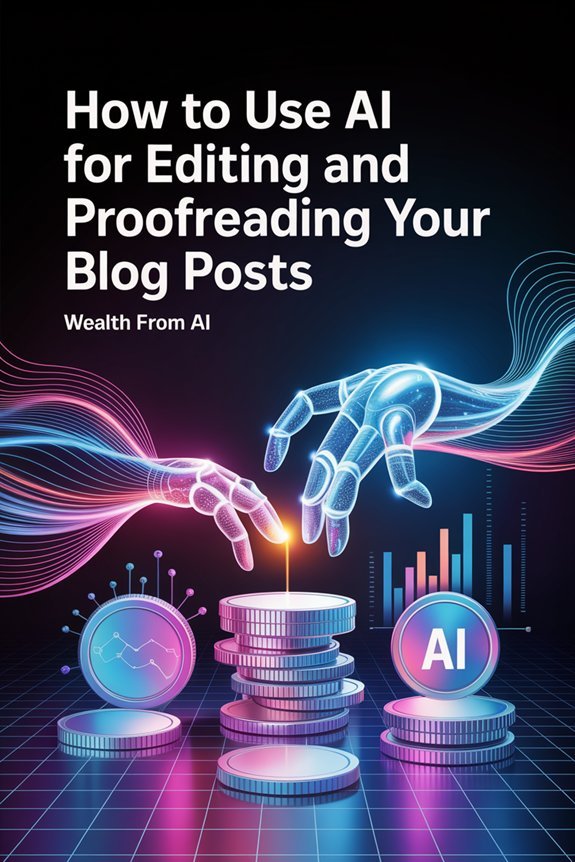Start by duplicating your document and processing it chapter-by-chapter through AI editing tools like Grammarly or ProWritingAid. Enable Track Changes in Word to monitor all modifications, then let the AI identify grammar errors, spelling mistakes, and punctuation issues. You'll need to manually review each suggestion against your original intent, preserving your distinctive voice while accepting grammatical improvements. Cross-check any AI-generated statistics against reputable sources, then read your content aloud to catch awkward phrasing the algorithms missed. The complete workflow below guarantees you'll maintain editorial control throughout the process.
Key Takeaways
- Use AI tools to automatically detect grammar errors, spelling mistakes, and punctuation issues in your blog content.
- Process your draft chapter-by-chapter with Track Changes enabled to document all AI modifications for review.
- Configure AI tools to analyze style consistency and tone alignment against your established editorial guidelines.
- Verify all AI-generated statistics and facts against reputable sources before publishing your content.
- Read your AI-edited content aloud to catch awkward phrasing and ensure your distinctive voice remains intact.
Understanding AI Editing and Proofreading Tools
While traditional proofreading demands meticulous line-by-line review, AI editing tools convert this labor-intensive process into a systematic workflow. You'll utilize these platforms to eliminate basic errors—verb tense inconsistencies, punctuation mistakes, and grammatical flaws—freeing your capacity for strategic content creation decisions.
These tools automate repetitive tasks that consume valuable time. You'll establish efficient workflows by duplicating files, configuring editing parameters, and processing content systematically. This approach enables you to concentrate on substantive improvements rather than mechanical corrections.
However, you must recognize inherent limitations. AI editing tools struggle with nuanced word alterations and contextual interpretation. You'll need a human editor's oversight for complex linguistic decisions and subtle meaning adjustments.
Your competitive advantage emerges from this hybrid methodology: deploy AI for foundational proofreading while reserving human judgment for sophisticated editorial refinements. A writer-friendly AI document editor can streamline your editing process by combining automated corrections with intuitive interfaces designed specifically for content creators.
As these technologies advance, you'll gain access to improved customization features and specialized editing capabilities that elevate your content excellence.
Setting Up Your AI Editing Workflow
Before initiating AI-assisted editing, you'll establish a protective workflow that preserves your original content. Start by duplicating your document and switching to editing mode. This safeguards your baseline while enabling thorough revision tracking.
When editing begins, process your content strategically using the Writing Tools menu. Target individual chapters rather than entire documents—smaller selections prevent AI tools from overwhelming and failing mid-process.
| Workflow Stage | Action Required | Purpose |
|---|---|---|
| Initial Setup | Duplicate file, enable editing mode | Preserve original content |
| AI Processing | Use Writing Tools chapter-by-chapter | Minimize tool failures |
| Review Phase | Activate Track Changes in Microsoft Word | Label all modifications |
After AI processing concludes, save immediately to document all modifications. Enable Track Changes in Microsoft Word's reviewing mode to distinguish between automated and manual edits. Complete your workflow with human proofreading—this critical step catches oversights while maintaining your distinctive voice and authoritative tone. Beyond editing, AI tools and productivity guides can help you optimize other aspects of your blogging workflow.
Transferring Your Draft to AI Tools

Once your workflow foundation is established, you'll prepare your draft for AI processing by selecting the appropriate transfer method. When transferring your draft to AI tools, execute a direct copy-paste into the application while maintaining original formatting to preserve document integrity.
Deploy compatible file formats—Google Docs or Word documents—to guarantee smooth integration with AI proofreading systems.
Use Google Docs or Word formats to ensure seamless compatibility with AI proofreading platforms and maintain document integrity throughout the editing process.
Segment your content into discrete paragraphs or sections. This strategic division enables the AI to process your material with maximum analytical precision, preventing system overload that compromises output quality.
Before initiating the editing process, verify your draft's organizational structure and save it systematically to eliminate potential confusion.
Master your selected AI tool's specific features and configuration settings. This technical proficiency allows you to calibrate the system according to your blog's distinctive voice and stylistic requirements.
Understanding these parameters gives you complete command over the editing process, altering AI proofreading from a basic function into a precision instrument for content optimization. Consider how boosting team productivity through AI tools can transform your entire content creation workflow beyond individual blog post editing.
Identifying Grammar, Spelling, and Punctuation Errors
AI proofreading tools detect three fundamental error categories with measurable accuracy: grammar violations, spelling mistakes, and punctuation defects. You'll utilize these tools to eliminate verb tense inconsistencies and punctuation failures that undermine your blog posts' credibility.
| Error Type | AI Capability |
|---|---|
| Basic Grammar | High accuracy on verb tense, subject-verb agreement |
| Spelling | Thorough detection of misspellings |
| Punctuation | Effective for commas, periods, missing list elements |
Process smaller text selections to optimize detection accuracy and minimize system failures. AI proofreading tools excel at straightforward corrections but require your oversight for nuanced contexts, particularly dialogue sequences. Enable track changes in your word processor to document every modification—this creates an audit trail of AI-suggested edits. You'll verify each correction before publication, ensuring AI efficiency improves rather than replaces your editorial judgment. These AI-powered writing tools can unlock new levels of creativity while maintaining technical precision in your content. This methodology alters grammar errors from publication liabilities into systematically addressable issues.
Leveraging AI for Style and Tone Consistency

Beyond surface-level corrections, AI proofreading tools analyze your content for style uniformity and tonal alignment across entire documents.
These AI writing tools measure your text against established guidelines, ensuring your voice remains authoritative and consistent from introduction to conclusion.
You'll harness advanced capabilities to refine sentence structure and enhance word choice, maintaining the precise tone your audience expects.
Configure customizable settings to define your brand's specific style parameters—these controls guarantee writing consistency that reinforces your professional standards.
Deploy AI-generated text comparisons between drafts to identify tonal shifts and stylistic deviations.
You'll spot inconsistencies immediately, enabling swift corrections before publication. This systematic approach eliminates the guesswork from maintaining style and tone consistency.
As you integrate these tools into your workflow, the AI adapts to your preferences, learning your unique patterns.
This iterative process strengthens your command over editorial quality, delivering the polished, professional content that establishes your authority.
Verifying Factual Accuracy and Statistics
While AI tools excel at generating content rapidly, they frequently produce statistics that require rigorous verification before publication. You must cross-check every AI-generated statistic against reputable sources to maintain your authority and credibility.
Deploy fact-checking websites like Snopes or FactCheck.org to verify claims before they reach your audience. Your strategy demands precision: ascertain all statistics originate from credible sources such as established research institutions or recognized industry organizations.
Outdated data undermines your position—validate that every figure reflects current research and the latest available information. Maximize your blog's credibility by embedding hyperlinks to original sources directly within your content.
This approach enables readers to independently verify your claims while demonstrating transparency. Use AI to help optimize your research process, but never bypass manual verification. The tools serve you—not the reverse.
Your readers expect accuracy, and delivering verified, source-backed statistics separates authoritative content from amateur work.
Reviewing and Refining AI Suggestions

Before you accept any AI-generated edit, scrutinize each suggestion against your original intent and verify its accuracy through independent research. Cross-reference claims with authoritative sources to maintain content integrity.
When reviewing AI tools' recommendations, preserve your distinctive voice while evaluating grammatical improvements. Utilize Microsoft Word's track changes feature to separate AI modifications from your original text, establishing a clear audit trail.
Examine each suggestion for common AI failures: awkward phrasing, contextual gaps, and logical inconsistencies. Refine these elements methodically to improve clarity and flow. Maintain consistency across tone, style, and terminology throughout your content.
The final step requires reading your revised text aloud. This technique exposes unnatural cadences and rhythm disruptions that silent reading misses. Make immediate corrections where the prose stumbles.
Your goal isn't merely accepting AI suggestions—it's commanding them to serve your vision while ensuring every word reinforces your message's impact and precision.
Maintaining Your Unique Voice Through Manual Edits
Although AI excels at correcting grammar and syntax, it can't replicate the personal quirks, rhythms, and stylistic fingerprints that distinguish your writing from generic content.
Manual edits give you control over maintaining your unique voice while utilizing AI efficiency.
Implement these strategic interventions to dominate AI-produced content:
- Compare systematically: Review AI outputs against your previous work to identify tone deviations.
- Insert specificity: Add concrete anecdotes and humor that reflect your perspective.
- Reclaim rhythm: Adjust sentence structures to match your natural cadence.
- Eliminate blandness: Replace generic phrases with distinctive expressions.
- Verify consistency: Confirm your voice remains cohesive across all sections.
Deploy a proofreading tool to handle technical accuracy while you concentrate on voice preservation.
This division of labor enhances efficiency without compromising authenticity.
Regular manual edits change sterile AI text into content that commands attention and builds authority with your audience.
Using Track Changes to Monitor AI Edits

Track Changes alters AI editing from a black box into a transparent workflow where every modification remains visible and reversible.
Begin by activating reviewing mode in your original document, establishing a baseline that captures every subsequent alteration. Configure comparison settings to character-level precision—this granularity guarantees you'll catch even subtle word substitutions or punctuation shifts that could compromise your message.
Label AI edits distinctly, either under a designated editor name or simply as “AI.” This classification gives you immediate visual control over which changes originated from algorithmic analysis versus human judgment.
When you review document modifications, systematically employ the Accept or Reject functions to evaluate each suggestion against your strategic objectives.
This methodical approach prevents passive acceptance of AI recommendations. You'll maintain authority over tone, technical accuracy, and brand consistency while leveraging AI's efficiency.
Your final output reflects deliberate choices, not automated defaults.
Reading Aloud for Final Quality Assurance
After AI completes its editing pass, you'll need a final verification method that catches what algorithms miss.
Reading your text aloud engages your auditory processing, revealing awkward phrasing, missing words, and rhythm issues that appear fluid on screen.
This technique allows you to evaluate whether your content flows naturally and sounds like authentic human communication rather than AI-generated text.
Catch Overlooked Errors
When you've completed multiple rounds of editing with AI tools, reading your blog post aloud serves as the essential final quality check that catches errors your eyes alone might miss. This auditory proofreading method forces deliberate engagement with every sentence, revealing issues that automated systems overlook.
You'll identify critical flaws through vocalization:
- Awkward phrasing that disrupts reader flow
- Inconsistent tone that weakens your authority
- Pacing problems that diminish impact
- Unclear passages requiring clarification
- Rhythm disruptions affecting readability
Verbalizing your content exposes stylistic weaknesses while AI tools handle technical corrections. This dual-layer approach guarantees thorough quality control.
Check for consistency in voice and messaging throughout your piece. Studies confirm that reading aloud improves retention and understanding, making overlooked mistakes immediately apparent.
Deploy this technique to assert dominance over every aspect of your written work.
Evaluate Natural Flow
Reading your blog post aloud changes silent review into an active diagnostic process that reveals your content's natural rhythm and flow. This technique exposes structural weaknesses that AI tools might miss—awkward shifts, jarring sentence structure, and pacing inconsistencies that disrupt reader engagement.
Your auditory processing identifies precisely where momentum stalls or arguments lose coherence.
Execute this practice after completing AI-assisted edits as your final quality checkpoint. Vocalization forces you to confront every word choice, revealing whether your tone commands authority and aligns with strategic objectives.
You'll detect redundancies and verify that each paragraph flows smoothly into the next. Reading aloud validates that your content maintains natural flow while preserving the power and precision your audience expects.
This step alters competent writing into commanding communication.
Frequently Asked Questions
Is There an AI Tool for Proofreading?
Yes, several best AI tools exist for proofreading, including Apple's writing suite and Grammarly.
You'll gain AI proofreading benefits like catching verb tense errors and automating repetitive tasks, accelerating your workflow considerably.
However, understand the limitations of AI—these tools struggle with nuanced dialogue and complex grammar.
The AI vs human debate is clear: you must maintain oversight to guarantee precision.
Integrate these tools strategically into your editing process, but don't rely on them exclusively for final authority.
How to Use AI for Blog Posts?
You'll optimize efficiency by deploying AI writing tools to generate your initial drafts, then systematically applying grammar checking algorithms to eliminate errors.
Execute content optimization through AI-driven analysis of readability scores and SEO metrics.
Implement style improvement tools to refine tone and consistency across sections.
Process your content strategically—feed smaller segments into AI systems for precise error detection, then layer in your unique expertise.
This methodical approach delivers professional-grade posts while you maintain complete editorial control and authentic voice.
Can I Use Chatgpt for Proofreading?
Want to eliminate errors without sacrificing control? You can utilize ChatGPT for proofreading, and it delivers substantial proofreading benefits through improved editing efficiency.
While ChatGPT accuracy excels at catching grammar and spelling mistakes, you'll need to maintain style consistency through human oversight.
Feed it smaller text sections for best performance. Don't rely solely on AI—integrate it strategically into your workflow where you retain final authority over every editorial decision, ensuring your content maintains its authoritative voice.
Can Google Detect Ai-Written Blogs?
Google can't definitively detect AI-written blogs, but its search engine algorithms evaluate content originality and quality patterns.
While AI detection methods exist, Google prioritizes value over authorship. You'll maintain power over your rankings by ensuring your AI writing tools produce unique, substantive content.
The key isn't avoiding AI—it's leveraging it strategically. Focus on delivering genuine insights and expert analysis that serves your audience's needs, and you'll bypass content originality concerns that trigger algorithmic scrutiny.
Conclusion
You've now equipped yourself with a precision toolkit that'll convert your rough drafts into polished gems. Think of AI as your vigilant co-pilot, catching errors while you steer the creative direction. By methodically applying each step—from initial grammar checks through final read-throughs—you'll craft content that resonates authentically. Remember: AI sharpens your blade, but you're the one wielding it. Balance automation with human intuition, and you'll consistently produce blog posts that shine with both technical accuracy and genuine voice.











